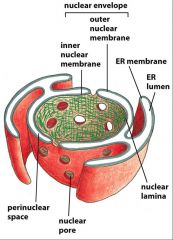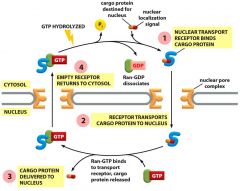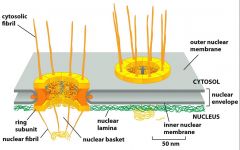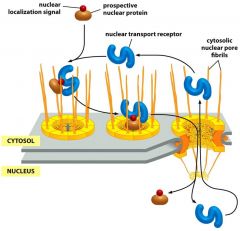![]()
![]()
![]()
Use LEFT and RIGHT arrow keys to navigate between flashcards;
Use UP and DOWN arrow keys to flip the card;
H to show hint;
A reads text to speech;
17 Cards in this Set
- Front
- Back
|
Protein synthesis--
Where? How? |
Where? ribosomes in rough ER, cytoplasm, mitochondria, chloroplast
How? mRNA made from DNA, read by ribosome (rRNA), tRNA brings in new amino acids |
|
|
Rationale for protein synthesis
|
-replacing old proteins
-adding more for daughter cell created during cell division Proteins are needed in specific locations throughout the cell |
|
|
How do proteins know where to go?
|
Proteins have unique AA codes that act as "sorting signals"
-specific organization = specific signal; signal sequence is important Cytoplasm has NO signal sequence--proteins are made there and remain there. |
|
|
How do proteins get inside organelles?
|
-nuclear envelope has pores
-other organelles have membrane protein translocators (proteins) -golgi gets proteins via vesicles from ER |
|
|
Nuclear anatomy
|

|
|
|
Nuclear pore complex
|
~30 different proteins
|
|
|
Nuclear pore
|
made up of various types of proteins
-cytosolic fibers (extended proteins) -ring subunit -nuclear basket/cage made of nuclear fibrils |
|
|
nuclear lamina
|
similar to the cell cortex, provides structure for nuclear membrane
|
|
|
Nuclear pore transport
|
-small molecules can pass freely
-large molecules must have correct sorting signal to pass with help of nuclear receptor protein |
|
|
Nuclear receptor proteins
|
in cytoplasm
-protein signal binds to transport receptor -importins and exportins -receptor proteins are the ones which actually bind to and are perceived by pore complex. |
|
|
Energy and Nuclear transport
|
Need energy for nuclear transport
GTP ->GDP + P + Energy ex: "Ran" binds to GTP, Nuclear receptor proteins bind with Ran for energy GTP = guanosine triphosphate (made in citric acid cycle) |
|
|
Ran
|
Binds to GTP for energy in nuclear transport
G protein with two confirmations: -bound to GTP -bound to GDP (after hydrolyzing GTP) |
|
|
G proteins
|
Ex: ran; "G-protein" if bind with GTP
G proteins are a member of GTPase superfamily of proteins (guanine nucleotide-binding proteins)(guanine is part of guanosine) -regulate cellular processes w/GTP |
|
|
Nuclear transport cycle
|

Ran-GTP binding to nuclear transport receptor releases cargo (changes confirmation)
|
|
|
Nuclear pores image
|

|
|
|
Nuclear transport
|

|
|
|
importin
|

|

